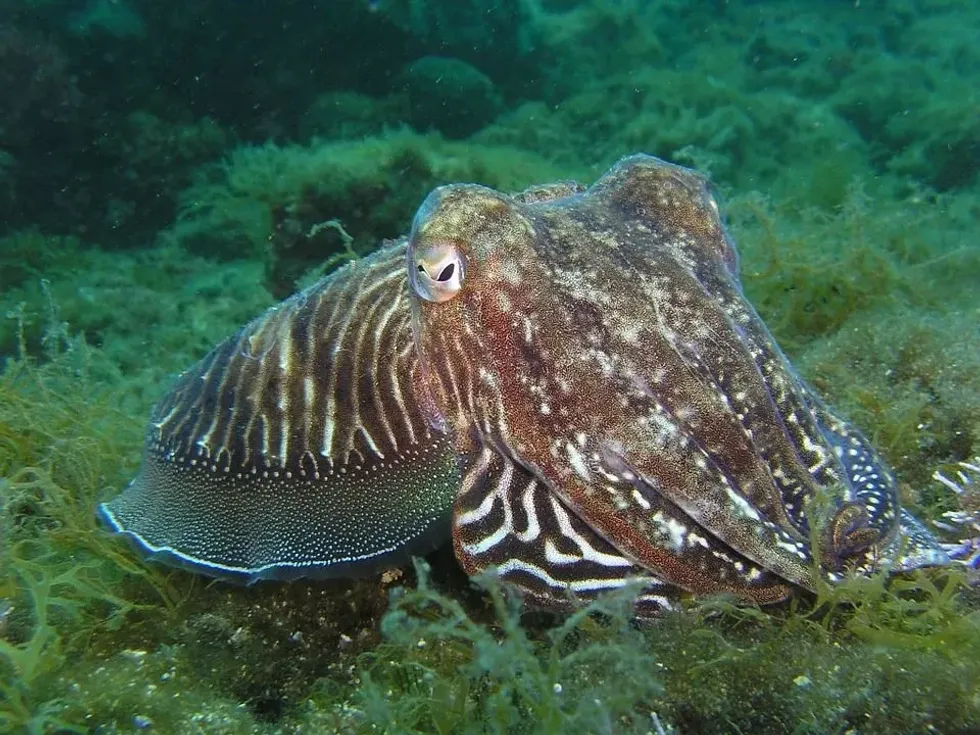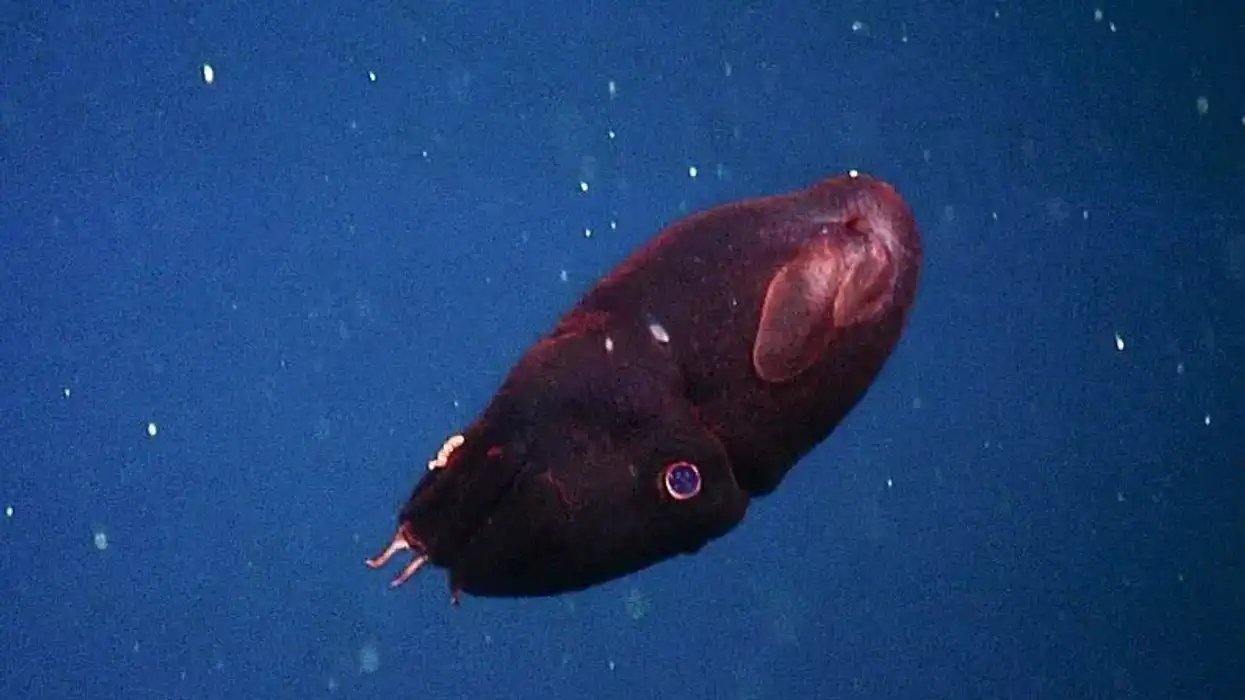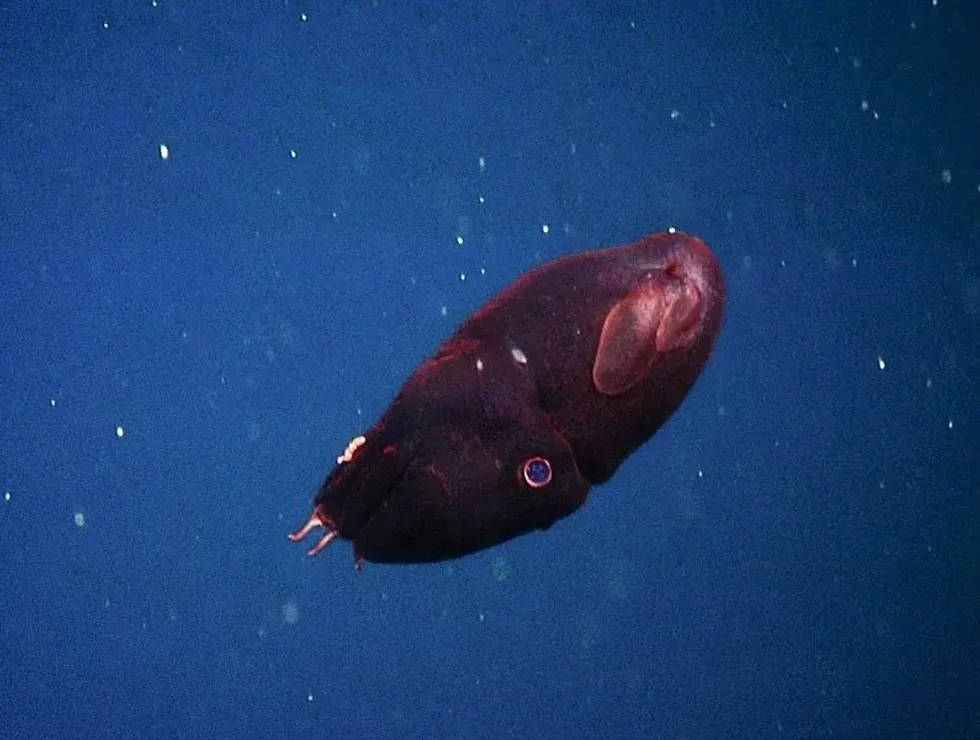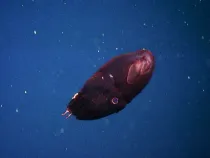Fun Vampire Squid Facts For Kids

Content
- What type of animal is a vampire squid?
- What class of animal does a vampire squid belong to?
- How many vampire squids are there in the world?
- Where does a vampire squid live?
- What is a vampire squid's habitat?
- Who do vampire squids live with?
- How long does a vampire squid live?
- How do they reproduce?
- What is their conservation status?
- What do vampire squids look like?
- How rare are they?
- How do they communicate?
- How big is a vampire squid?
- How fast can a vampire squid swim?
- How much does a vampire squid weigh?
- What are their male and female names of the species?
- What would you call a baby vampire squid?
- What do they eat?
- Are they poisonous?
- Would they make a good pet?
- Did you know...
- How deep can they go?
- How predatory are they?
The vampire squid (Vampyroteuthis infernalis), which literally means 'vampire squid from hell' lives in tropical oceans at extreme depths where the light does not reach through and where there is barely any oxygen, feeding mostly on marine snow.
It was first observed by Carl Chun during the Valdivia expedition in the year 1898, an expedition to study life at the depths of the ocean.
The vampire squid has two retractile filaments making it a unique species, different from octopuses and squids. It has eight arms connected by a webbed skin but lacks tentacles to help it feed itself. They are swift swimmers capable of covering two body lengths every second and they also have large eyes, spanning 1 in (2.5 cm) in diameter.
During their phases of development, the young vampire squid has a single pair of fins and, as they grow, they form two more pairs of fins.
Their fins keep developing as the body grows and as the surface area to volume ratio decreases, the fins are displaced to a different position which allows for a high motion efficiency. Adult vampire squids have a pair of fins that look like ears on the side of their mantle.
These pairs of fins are used for propulsion when they navigate through water, by flapping their fins.
According to the Biological Bulletin, a journal publishing experimental research, their body is covered with photophores which are light-producing organs.
The vampire squid uses these light-producing organs to survive in the deep against predators.
Although vampire squids are believed to be quite harmless, their behavior when facing a predator shows that they have a few tricks up their sleeves, some of which include the 'pineapple' posture or the 'pumpkin' posture, which involve the vampire squid flipping its arms over its body to make itself larger to the predator while keeping the glowing parts of the arm away from its head to distract any attacks intended to its head or other vital organs.
During the 'pineapple' posture, if any of the squid's arms are damaged, it can simply regenerate them back.
Vampire Squid Interesting Facts
What type of animal is a vampire squid?
The vampire squid (Vampyroteuthis infernalis) is a small cephalopod that lives in the great depths of the ocean, where not a lot of light gets through and it is low in oxygen levels.
They are quite harmless to any other species, but with the help of their velar filament they are able to detect vibrations around them and if needed they can perform quick maneuvers to investigate and escape. This burst of speed can only last for a short time as they lack stamina due to their weak muscle development.
To survive at an oxygen minimum layer, vampire squids depend on their slow metabolism that conserves oxygen.
They have copper-based blue blood called hemocyanin, which ensures oxygen is bound well into their blood. Their gills are also large to accommodate high oxygen intake.
Even its way of eating is designed to use the least energy possible, and it often drifts in the deep ocean with minimal movements instead of constant swimming, unless it comes across a predator.
What class of animal does a vampire squid belong to?
Although they are classified as cephalopods, they are not related to either octopuses or squids and scientists consider them to be of a different class.
How many vampire squids are there in the world?
Vampire squids were discovered fairly recently around 1899, and due to the fact that these cephalopods live at the extreme depths of the ocean, not a lot of research has been conducted about the number of vampire squids in the world.
Where does a vampire squid live?
They live in the deep sea of temperate and tropical oceans.
What is a vampire squid's habitat?
The vampire squid's range is within tropical and subtropical oceans, where only darkness reigns, and there is little to no oxygen. They do not like to be in places where there is a lot of light. They keep themselves to these cold deep waters, where the range of temperature is between 36-43 F (2-6 C).
Who do vampire squids live with?
They are usually observed to live alone at the depths of the ocean and it is rare for vampire squids to meet even their own kind.
How long does a vampire squid live?
It is speculated that vampire squids can live for up to 10 years.
How do they reproduce?
As vampire squids are rare to spot, and given the fact that they live so deep within the ocean where there is no light, the reproduction process for a vampire squid is a chance occurrence.
When vampire squids spot another one of their own species, which is surprisingly rare, they signal each other using their bioluminescent capabilities and proceed to breed.
Female vampire squids reach maturity after two years of life and after this, they can constantly reproduce throughout their life. To reproduce, a male vampire squid passes packets to females, who then store these packets before they are subjected to fertilization.
After 13 months, the females lay their eggs and most of them die of starvation as they do not consume any food during the gestation period.
The babies do not need to eat after their birth as they are born with internal energy reserves which help them to survive for a while until they are capable of eating food. They look mostly like their adult parents right after birth at just 0.31 in (8 mm) in size.
What is their conservation status?
When it comes to their conservation status, very little is known about vampire squids due to their hard-to-reach habitat, hence, their conversation status is currently Not Evaluated by the IUCN (International Union for Conservation of Nature).
According to all the research on them, it is evident that they have been living in the depths for more than 300 million years and the fact that they were discovered quite recently is quite fascinating.
They are not even likely to be considered endangered.
Vampire Squid Fun Facts
What do vampire squids look like?
The vampire squid is a cephalopod, living in the depths of temperate and tropical oceans. It has a dark exterior, that is mostly black and slightly red.
Depending on how deep the squid lives, and how much light gets through, its skin can be darker or lighter. It has a gelatinous look which makes its appearance closer to that of a jellyfish than to regular squids (such as the one seen below) or octopi.
A fully grown adult vampire squid will have developed a pair of fins on either side of its body, enabling the cephalopod to traverse through the waters at two body lengths per second. They have eight webbed arms that are covered with cirrate octopods which look like a spine.
They also have suckers at the end of each arm. They have one of the largest eyes on any animal in the world, which can be of two colors: blue or red, depending on the amount of light in which it lives among.
In the middle of the circle of arms, they have white beaks.
They also have two pouches to hold their tactile filament that is hidden beneath their first and second arms. These filaments can grow to twice their own body size!
These animals also have light-producing organs called photophores on the surface of their body, and on their head are two white photoreceptors. Vampire squids have immense control of the photophores on their body.
They can either completely switch them off to a point where there will be no light emitted which, considering the deep ocean, will make the Vampire Squids almost invisible. They can also modulate the photophores to produce marvelous patterns all over their body, which is useful to confuse any occasional predators.
Just like squids and octopi, vampire squids have chromatophores which help in changing the color of their skin at will. This helps them when hunting for food or trying to deter predators.
This aspect is not as well developed in vampire squids, and therefore they cannot change their colors quite like other squids or octopi can. The reason why this ability is not as developed for vampire squids is probably that they have no need to have such a survival technique in the depths at which they dwell.

*Please note that this is an image of a squid, not a vampire squid specifically. If you have an image of a vampire squid, please let us know at hello@kidadl.com.
How rare are they?
Since their natural habitat is a place where we humans find it difficult to get to, it is very rare to see vampire squids in person. Due to the lack of light and oxygen at these depths, we mostly rely on pods or drones which can handle the water pressure to study their behavior.
They are not only rare to us humans, they are rare to themselves.
Vampire squids often do not come across another one of their own species for a long time.
This makes it hard for them to breed, so if by any chance they do spot another vampire squid, they will communicate using their bioluminescent organs, and if it happens to be of the opposite gender, the pair are sure to breed.
Judging by this, it's safe to say that they are quite rare in our world, at least our known world underneath the ocean!
How do they communicate?
Vampire squids usually respond to threats differently to octopi or other squids. Instead of discharging black ink, they discharge bioluminescent particles and the lights produced from these particles are quite effective at puzzling its predators.
They can also produce lights at the tips of their eight arms, which is considered to be a form of communication between male and female vampire squids.
How big is a vampire squid?
Vampire Squids are small creatures and they are roughly four times smaller when compared to their cousin, the octopus.
How fast can a vampire squid swim?
For a small creature, the vampire squid is surprisingly fast, as it can travel two times its own body length in a second.
How much does a vampire squid weigh?
On average, vampire squids have been observed to weigh only 1 lb (0.45 kg).
What are their male and female names of the species?
The male and female of the vampire squid species are not referred to by unique names.
What would you call a baby vampire squid?
Baby vampire squids are simply referred to as baby vampire squids.
What do they eat?
They do not feed on any live animals, making them quite harmless in general.
They are not capable of using their arms to aid feeding, but instead, they rely on their retractile filament and the small hairs on their bodies that are composed of sensory cells which help them detect their prey.
Their food includes small dead planktonic creatures, fecal pellets, and some organic materials from around the ocean which they merge with mucus secretion from suckers to make food balls.
It was also once recorded that the stomach contents of a vampire squid included fish bones and flesh of other squids.
Are they poisonous?
It is known that the vampire squid's cousins, the octopus and regular squids release ink at their predators at the sight of these predators or if they feel threatened.
Vampire squids have developed a similar mechanism, except instead of ink they release a cloud of sticky mucus that is bioluminescent in nature. This most of the time deceives the vampire squid's predators long enough for it to make its escape.
Although this may make for a good visual obstruction, these are in no way poisonous and they do not cause any harm to the predators.
Would they make a good pet?
Given that the vampire squid's habitat is home to some of the rarest creatures in the Animal Kingdom, and that they live at the very depths of the ocean where light does not reach and oxygen is almost non-existent, we can be sure that vampire squids will not be able to survive in our living conditions if we were to adopt them as pets.
Neither can humans survive at the depths at which these species manage to live.
Therefore, it is safe to say that vampire squids will definitely not make good pets.
Did you know...
They are called vampire squids, not because they suck blood like the lore of the vampire world, but instead because they have developed a certain part of their skin that connects to their arms and has an uncanny resemblance to a cape, which reminds us of vampires from the cartoons and movies that can turn into bats and drink blood!
It also helps that their skin is dark and they live in the pitch darkness of the deeper parts of the ocean.
Even though they live at such great depths of the ocean, they are at risk from a number of natural predators. It has been found that parts of vampire squids were found in the stomachs of giant grenadiers, large fish, whales, and surprisingly, sea lions.
Not all creatures can survive without light and oxygen at the very depths of the ocean where vampire squids have decided to live, and hence, these vampire squids have evolved to eat food sparsely.
They consume dead planktons, fecal pellets, and marine snow whenever they get the chance, and are able to not eat for a few days if required.
Vampire squids, although they rely on their arms and the pair of fins on each side for navigating through the deep oceans, gain momentum when swimming by ejecting water from a well-concealed organ.
There is only one species of vampire squid in the world and it is currently the only serving member of the order Vampyromorphida. Despite this, scientists believe that there were more species from the order Vampyromorphida as fossils have been found with similar features.
Interestingly, in the event that it fails to lose its predator with its usual tricks, as a last resort, this deep-sea 'vampire squid from hell' can stick its special bioluminescent mucus onto the predator itself. This technique has a riveting effect on the predator.
With the mucus stuck on the predator, the predator ends up attracting its own predator as it is glowing brightly in the deep sea, now making them the prey.
How deep can they go?
They can go as far as 2000-3000 ft (610-915 m) under the sea, using their fins to help travel through the seas.
How predatory are they?
They are known to be completely harmless creatures who generally keep to themselves throughout their lives. They don't even attack their own predators for self-defense, only using neat tricks to deceive them and escape.
Here at Kidadl, we have carefully created lots of interesting family-friendly animal facts for everyone to discover! Learn more about some other cephalopods including the Caribbean reef shark or the grey reef shark.
You can even occupy yourself at home by drawing one on our Vampire squid coloring pages.
We Want Your Photos!
More for You
Bachelor of Commerce specializing in Accounting and Finance, Master of Business Administration

Divya RaghavBachelor of Commerce specializing in Accounting and Finance, Master of Business Administration
With a diverse range of experience in finance, administration, and operations, Divya is a diligent worker known for her attention to detail. Born and raised in Bangalore, she completed her Bachelor's in Commerce from Christ University and is now pursuing an MBA at Narsee Monjee Institute of Management Studies, Bangalore. Along with her professional pursuits, Divya has a passion for baking, dancing, and writing content. She is also an avid animal lover who dedicates her time to volunteering for animal welfare causes.
Bachelor of Arts specializing in Psychology

Shreya YadavBachelor of Arts specializing in Psychology
Shreya has developed a diverse set of skills through her experience in client servicing, email marketing, content and e-commerce management, digital marketing, and creative content writing. Her educational background includes a Bachelor's degree in Psychology from Indira Gandhi National Open University, Delhi. Shreya's passion for ongoing learning and development is a testament to her commitment to excellence.
Disclaimer
1) Kidadl is independent and to make our service free to you the reader we are supported by advertising. We hope you love our recommendations for products and services! What we suggest is selected independently by the Kidadl team. If you purchase using the Buy Now button we may earn a small commission. This does not influence our choices. Prices are correct and items are available at the time the article was published but we cannot guarantee that on the time of reading. Please note that Kidadl is a participant in the Amazon Services LLC Associates Program, an affiliate advertising program designed to provide a means for sites to earn advertising fees by advertising and linking to Amazon. We also link to other websites, but are not responsible for their content.
2) At Kidadl, we strive to recommend the very best activities and events. We will always aim to give you accurate information at the date of publication - however, information does change, so it’s important you do your own research, double-check and make the decision that is right for your family. We recognise that not all activities and ideas are appropriate for all children and families or in all circumstances. Our recommended activities are based on age but these are a guide. We recommend that these ideas are used as inspiration, that ideas are undertaken with appropriate adult supervision, and that each adult uses their own discretion and knowledge of their children to consider the safety and suitability. Kidadl cannot accept liability for the execution of these ideas, and parental supervision is advised at all times, as safety is paramount. Anyone using the information provided by Kidadl does so at their own risk and we can not accept liability if things go wrong.
3) Because we are an educational resource, we have quotes and facts about a range of historical and modern figures. We do not endorse the actions of or rhetoric of all the people included in these collections, but we think they are important for growing minds to learn about under the guidance of parents or guardians.







